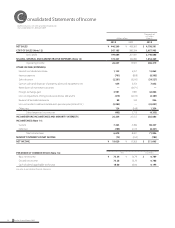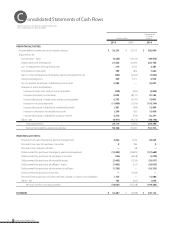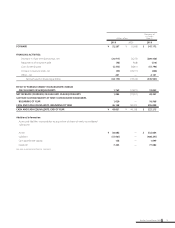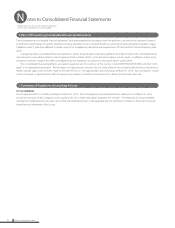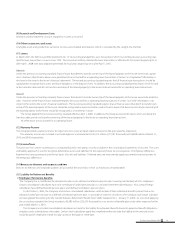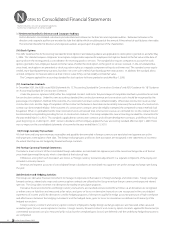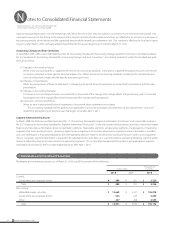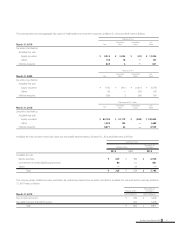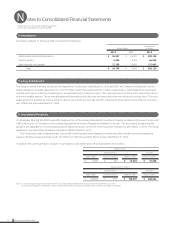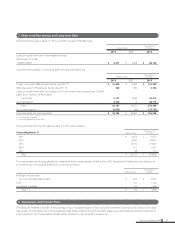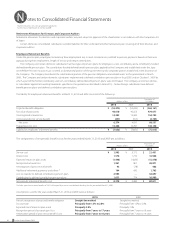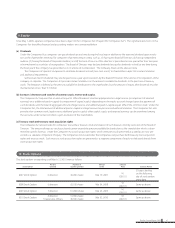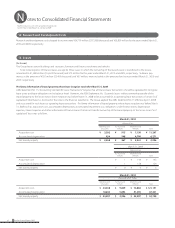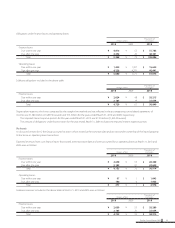Brother International 2010 Annual Report Download - page 27
Download and view the complete annual report
Please find page 27 of the 2010 Brother International annual report below. You can navigate through the pages in the report by either clicking on the pages listed below, or by using the keyword search tool below to find specific information within the annual report.
The interest rate swaps that qualify for hedge accounting and meet specific matching criteria are not remeasured at market value but the
differential paid or received under the swap agreements are recognized and included in interest expense or income.
(21) Per Share Information
Basic net income per share is computed by dividing net income available to common shareholders by the weighted average number of common
shares outstanding for the period, retroactively adjusted for stock splits.
Diluted net income per share reflects the potential dilution that could occur if securities were exercised. Diluted net income per share of
common stock assumes full exercise of outstanding warrants at the beginning of the year (or at the time of issuance).
Cash dividends per share presented in the accompanying consolidated statements of income are dividends applicable to the respective years
including dividends to be paid after the end of the year.
(22) New Accounting Pronouncements
Business Combinations
In December 2008, the ASBJ issued a revised accounting standard for business combinations, ASBJ Statement No. 21, “Accounting Standard for
Business Combinations.” Major accounting changes under the revised accounting standard are as follows:
(1) The current accounting standard for business combinations allows companies to apply the pooling of interests method of accounting
when certain specific criteria are met such that the business combination is essentially regarded as a uniting-of-interests. The revised
standard requires to account for such business combination by the purchase method and the pooling of interests method of accounting is
no longer allowed.
(2) The current accounting standard accounts for the research and development costs to be charged to income as incurred. Under the revised
standard, an in-process research and development (IPR&D) acquired by the business combination is capitalized as an intangible asset.
(3) The current accounting standard accounts for a bargain purchase gain (negative goodwill) to be systematically amortized within 20 years.
Under the revised standard, the acquirer recognizes a bargain purchase gain in profit or loss on the acquisition date after reassessing
whether it has correctly identified all of the assets acquired and all of the liabilities assumed with a review of such procedures used.
This standard is applicable to business combinations undertaken on or after April 1, 2010 with early adoption permitted for fiscal years begin-
ning on or after April 1, 2009.
Unification of Accounting Policies Applied to Foreign Associated Companies for the Equity Method
The current accounting standard requires to unify accounting policies within the consolidation group. However, the current guidance allows to
apply the equity method for the financial statements of its foreign associated company which have been prepared in accordance with generally
accepted accounting principles in their respective jurisdictions without unification of accounting policies.
In December 2008, the ASBJ issued ASBJ Statement No. 16 (Revised 2008), “Revised Accounting Standard for Equity Method of Accounting for
Investments.” The new standard requires adjustments to be made to conform the associate’s accounting policies for similar transactions and
events under similar circumstances to those of the parent company when the associate’s financial statements are used in applying the equity
method unless it is impracticable to determine adjustments. In addition, financial statements prepared by foreign associated companies in accor-
dance with either International Financial Reporting Standards or the generally accepted accounting principles in the United States tentatively may
be used in applying the equity method if the following items are adjusted so that net income is accounted for in accordance with Japanese GAAP
unless they are not material: 1) amortization of goodwill; 2) scheduled amortization of actuarial gain or loss of pensions that has been directly
recorded in the equity; 3) expensing capitalized development costs of R&D; 4) cancellation of the fair value model accounting for property, plant,
and equipment and investment properties and incorporation of the cost model accounting; 5) recording the prior years' effects of changes in
accounting policies in the income statement where retrospective adjustments to the financial statements have been incorporated; and 6) exclu-
sion of minority interests from net income, if contained.
This standard is applicable to equity method of accounting for investments effective on or after April 1, 2010 with early adoption permitted for
fiscal years beginning on or after April 1, 2009.
Asset Retirement Obligations
In March 2008, the ASBJ published a new accounting standard for asset retirement obligations, ASBJ Statement No. 18, “Accounting Standard for
Asset Retirement Obligations” and ASBJ Guidance No. 21, “Guidance on Accounting Standard for Asset Retirement Obligations.” Under this account-
ing standard, an asset retirement obligation is defined as a legal obligation imposed either by law or contract that results from the acquisition,
construction, development and the normal operation of a tangible fixed asset and is associated with the retirement of such tangible fixed asset.
The asset retirement obligation is recognized as the sum of the discounted cash flows required for the future asset retirement and is recorded
in the period in which the obligation is incurred if a reasonable estimate can be made. If a reasonable estimate of the asset retirement obligation
cannot be made in the period the asset retirement obligation is incurred, the liability should be recognized when a reasonable estimate of asset
retirement obligation can be made. Upon initial recognition of a liability for an asset retirement obligation, an asset retirement cost is capitalized
by increasing the carrying amount of the related fixed asset by the amount of the liability. The asset retirement cost is subsequently allocated to
25Brother Annual Report 2010



